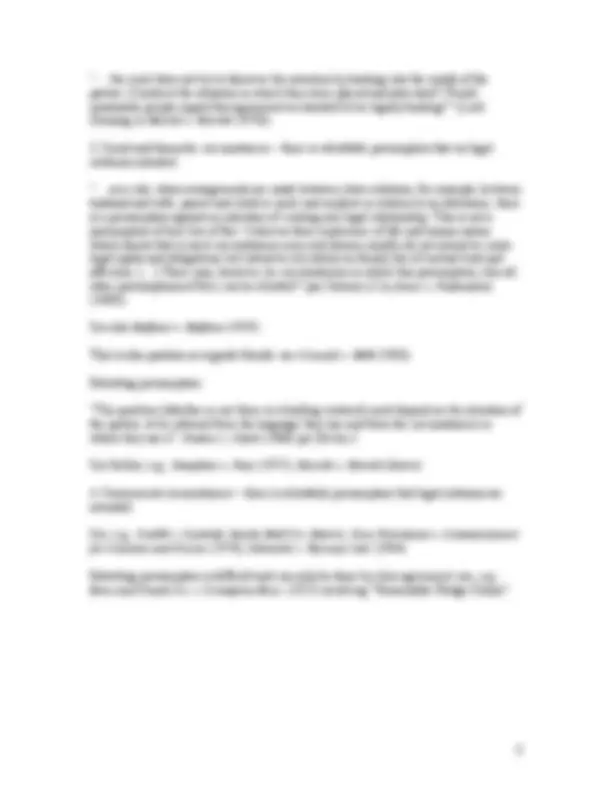



Study with the several resources on Docsity

Earn points by helping other students or get them with a premium plan


Prepare for your exams
Study with the several resources on Docsity

Earn points to download
Earn points by helping other students or get them with a premium plan
Community
Ask the community for help and clear up your study doubts
Discover the best universities in your country according to Docsity users
Free resources
Download our free guides on studying techniques, anxiety management strategies, and thesis advice from Docsity tutors
An in-depth analysis of the legal concepts of acceptance and intention to create legal relations in contract law. It covers various aspects of acceptance, including its definition, requirements, and exceptions. Additionally, it discusses the time period for acceptance and the importance of intention to create legal relations in contract formation. Essential for students and practitioners seeking a thorough understanding of contract law.
What you will learn
Typology: Lecture notes
1 / 3

This page cannot be seen from the preview
Don't miss anything!


Ad. (i): acceptance may be oral, written or by conduct on part of offeree. Need to be able to infer intention by offeree to be bound by terms of offer. Cannot stipulate silence as acceptance: see Felthouse v. Bindley (1862). Cf. Re Selectmove Ltd. (1995).
Ad. (ii): person must know of offer in order to be able to accept it, but motive in accepting is irrelevant.
Ad. (iii): reply to offer is only effective as acceptance if it accepts all terms of offer without qualifications, reservations or additions: see, e.g., Nicolene v. Simmonds (1953). Thus, conditional acceptance ≠ acceptance: see, e.g., Winn v. Bull (1877). NB: The “battle of the forms” – Butler Machine Tool Co. Ltd. v. Ex-Cell-O- Corp. Ltd. (1979).
Ad. (iv): acceptance must be communicated and is effective when and where received by offeror. See, e.g., Entores v. Miles Far East Corp. (1955). Onus on offeree to get message through to offeror, and offeree must believe, as reasonable person, that acceptance has been received. Thus, reasonable expectations of offeree = point of departure for resolving issue of when and whether communication of acceptance has occurred. See espec. Brinkibon v. Stahag Stahl (1982). (Poole: “a general principle appears to be identifiable, namely that if the offeree has done all that he might reasonably be expected to do to get his message through, that acceptance should take effect when the offeree might reasonably expect it to be communicated to the offeror” (9th^ ed., p. 73))
Specifying method of acceptance? If offeror stipulates that offer must be accepted in a certain way then only acceptance by that method – or an equally effective one – will be binding. To be equally effective, the alternative acceptance method must be at least as fast and as advantageous for the offeror as the method stipulated by the offeror: see Tinn v. Hoffman (1873); cf. Quenerduaine v. Cole (1883).
If specified method of acceptance is only included for benefit of offeree, then latter does not have to use that method: see, e.g., Yates Building Co. Ltd. v. J. Pulleyn & Sons (York) Ltd. (1975).
Exceptions to communication rule: Communication waived by offeror – typical in case of unilateral contract ( Carlill v. Carbolic Smoke Ball Co. ); However, offeror may not bind offeree by stipulating that silence = consent ( Felthouse v. Bindley ); Conduct of offeror – if offeror does not receive acceptance due to their own fault ( Brinkibon ; The Brimnes (1975)); Postal rule: If reasonable to use post, acceptance deemed completed on posting: Adams v. Lindsell (1818) o Postal rule may not apply if offeror (expressly or impliedly) excludes it: Holwell Securities v. Hughes (1974); o Postal rule does not apply when acceptance is by instantaneous mode of communication (telephone, telex, etc.) (and sent and received within ordinary working hours): Brinkibon ; Entores ; The Brimnes. Status of message left on telephone answering machine? (Poole, 9th^ ed., p. 74) Status of fax? = instantaneous mode of communication ( J.S.C. Zestafoni Nikoladze Ferroalley Plant v. Ronly Holdings Ltd (2004)) Status of email communication? (Poole, 9th^ ed., p. 75–76: preferred approach is to treat this as instantaneous communication. Also High Court of Singapore takes this line: see Chwee Kin Keong v. Digilandmall.com Pte Ltd (2004)).